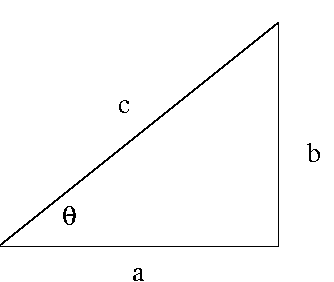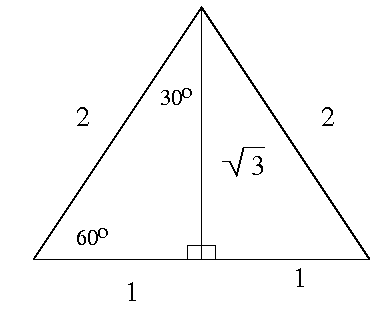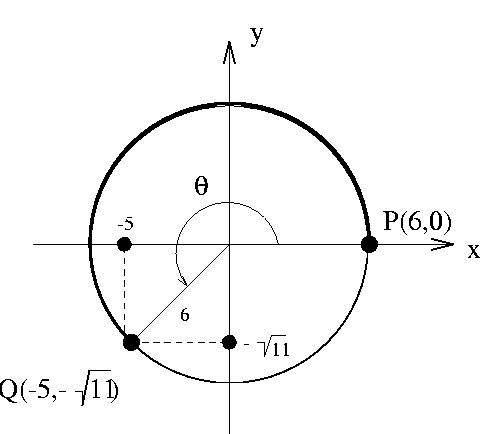a real number

can be interpreted as the measure of the angle constructed as follows: wrap a piece of string of length

units around the unit circle

(counterclockwise if

, clockwise if

) with initial point
P(1,0) and terminal point
Q(
x,
y). This gives rise to the central angle with vertex
O(0,0) and sides through the points
P and
Q. All six trigonometric functions of

are defined in terms of the coordinates of the point
Q(
x,
y), as follows:

Since
Q(
x,
y) is a point on the unit circle, we know that

. This fact and the definitions of the trigonometric functions give rise to the following fundamental identities:

This modern notation for trigonometric functions is due to L. Euler (1748).
More generally, if
Q(
x,
y) is the point where the circle

of radius
R is intersected by the angle

, then it follows (from similar triangles) that

Periodic Functions
If an angle

corresponds to a point
Q(
x,
y) on the unit circle, it is not hard to see that the angle

corresponds to the same point
Q(
x,
y), and hence that

Moreover,

is the smallest positive angle for which Equations
1 are true for any angle

. In general, we have for all angles

:

We call the number

the
period of the trigonometric functions

and

, and refer to these functions as being
periodic. Both

and

are periodic functions as well, with period

, while

and

are periodic with period

.
EXAMPLE 1 Find the period of the function

.
Solution: The function

runs through a full cycle when the angle 3
x runs from 0 to

, or equivalently when
x goes from 0 to

. The period of
f(
x) is then

.
EXERCISE 1 Find the period of the function

.
Solution
Evaluation of Trigonometric functions
Consider the triangle with sides of length

and hypotenuse
c>0 as in Figure 1 below:
 |
| Figure 1 |
For the angle

pictured in the figure, we see that
There are a few angles for which all trigonometric functions may be found using the triangles shown in the following Figure 2.
 |
 |
| Figure 2 |
This list may be extended with the use of
reference angles (see Example 2 below).
EXAMPLE 1: Find the values of all trigonometric functions of the angle

.
Solution: From Figure 2, we see that the angle of

corresponds to the point

on the unit circle, and so
 EXAMPLE 2:
EXAMPLE 2: Find the values of all trigonometric functions of the angle

.
Solution: Observe that an angle of

is equivalent to 8 whole revolutions (a total of

) plus

, Hence the angles

and

intersect the unit circle at the same point
Q(
x,
y), and so their trigonometric functions are the same. Furthermore, the angle of

makes an angle of

with respect to the x-axis (in the second quadrant). From this we can see that

and hence that

We call the auxiliary angle of

the
reference angle of

.
EXAMPLE 3 Find all trigonometric functions of an angle

in the third quadrant for which

.
Solution: We first construct a point
R(
x,
y) on the terminal side of the angle

, in the third quadrant. If
R(
x,
y) is such a point, then

and we see that we may take
x=-5 and
R=6. Since

we find that

(the negative signs on
x and
y are taken so that
R(
x,
y) is a point on the third quadrant, see Figure 3).
 |
| Figure 3 |
It follows that
 S.O.S.mathmatics
S.O.S.mathmatics
















댓글 없음:
댓글 쓰기